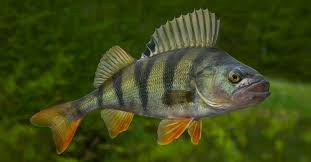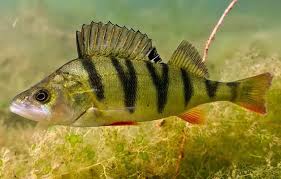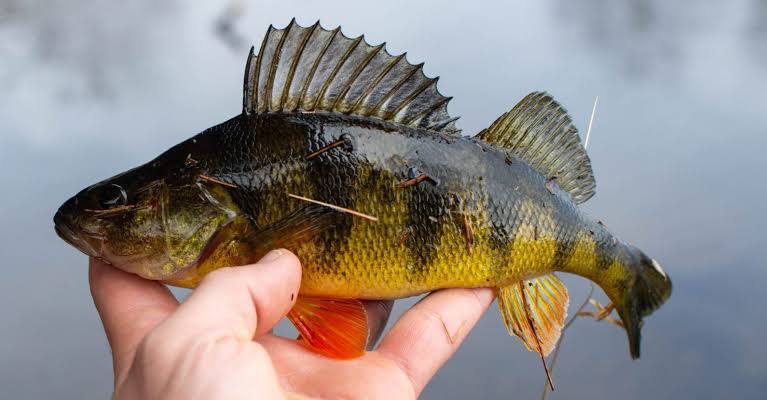Appearance and Features of Yellow Perch Fish
Yellow perch are small fish that live in freshwater. They’re colorful, with golden-yellow bodies and dark stripes on their sides. These fish like to hang out in lakes, ponds, and slow-moving rivers. They’re not very big, usually around 4 to 10 inches long.
These fish have a cool way of surviving. In winter, they slow down and don’t move much. They sort of chill out at the bottom of the water, almost like they’re sleeping. But when it gets warmer, they wake up and start swimming around again.
Yellow perch are picky eaters. They munch on bugs, small fish, and tiny creatures they find in the water. They have sharp little teeth that help them catch their food. They’re good at hiding too, using plants or rocks to stay safe from bigger fish who might want to snack on them.
People like to catch yellow perch for fun and sometimes to eat. They’re tasty, so some folks go fishing just to catch these little guys. But people need to be careful and not catch too many, so there are always enough perch left in the water for the next time.
In some places, yellow perch are really important. They help keep the balance in lakes and rivers by eating certain things and being food for bigger fish. So, even though they might be small, they play a big role in the underwater world!
Yellow perch are interesting because they change as they grow up. When they’re young, they eat lots of tiny creatures. But as they get older, they start eating more fish. It’s like they grow up and change their diets just like people do!
These fish are social creatures too. They like to hang out in groups, especially during certain times of the year. When it’s time for them to lay eggs, they gather together in big groups. It’s like a big family reunion, but underwater!
Their colors change with the seasons. In the spring and summer, they look brighter and more colorful. But when it gets colder in the fall and winter, their colors fade a bit. It’s like they’re wearing different outfits for different times of the year.
People who fish for yellow perch need to know the rules. There are limits on how many perch someone can catch in a day. This helps make sure there are always enough fish left in the water for everyone to enjoy. It’s like taking care of a special treasure so it doesn’t disappear.
Yellow perch might seem small, but they’re a big part of nature. They have their own special place in the water world, making it a better and more interesting place for everyone!
Read Also: Importance and Uses of a Farming Tractor
Appearance and Features of Yellow Perch

Yellow perch have a cool look. They’re small, about the length of a hand or so. Their bodies are golden-yellow, like a shiny coin, with stripes that run down their sides. These stripes are kind of like lines, dark and wavy, making them stand out. Their fins have a reddish tinge, adding a touch of color to their bright bodies.
They’ve got tiny scales covering their skin, almost like armor, which protects them. Their eyes are on the sides of their heads, which helps them keep an eye out for danger all around. And don’t forget about their sharp teeth! Even though they’re small, they’ve got lots of tiny, pointy teeth that help them catch their food. These teeth are perfect for grabbing onto small bugs or other little fish in the water.
History and Origin of Yellow Perch
Yellow perch have been around for a long, long time. They’re native to North America, especially places like the Great Lakes and other freshwater areas. People have known about these fish for centuries.
Native American tribes used to catch and eat yellow perch as part of their diets. They were a source of food and were important for their survival. Over time, as more people settled in these areas, fishing for yellow perch became a popular activity for fun and food.
In the 1800s, people started moving yellow perch to different places outside their native habitats. They thought it would be cool to have these fish in new lakes and rivers. Sometimes this worked out well, but other times it caused problems for the local fish and the environment.
Today, yellow perch are still loved by many fishermen and nature lovers. They’ve become a symbol of the natural beauty of freshwater environments and hold a special place in the history and culture of the regions they inhabit.
Read Also: Importance and Techniques Used in Regenerative Agriculture
Health and Lifespan of Yellow Perch

Yellow perch usually live for about 9 to 10 years, but some can live longer if conditions are good. However, they face some health issues like other fish.
Sometimes, they can get diseases from things in the water, like bacteria or parasites. These can make them sick, just like how people get sick sometimes. Pollution in their water homes can also make them unwell, affecting their health and ability to survive.
Also, when the places they live in get too crowded with other fish, it can make it harder for yellow perch to find food. This lack of food can make them weaker and more likely to get sick.
But when they’re in clean water with enough food and space, they’re usually healthier and live longer. It’s just like how we feel better and live longer when we eat well and have a nice place to live!
Nutrition and Feeding Mode of Yellow Perch
Yellow perch are pretty picky eaters! When they’re young, they like to snack on tiny creatures like insects, zooplankton, and small crustaceans. As they grow older, they switch their diets and start eating smaller fish. It’s like they change their menu as they grow up
They’re hunters in the water world. Their sharp teeth help them grab their prey, and they’re sneaky too, hiding near plants or rocks to ambush their meals. These little predators are good at finding food, especially in places with lots of hiding spots for their prey.
Their diet is important for their growth. When they eat well, they grow bigger and stronger. But if they can’t find enough food, they might not grow as much and could become weaker, affecting their health. So, having a good variety of food to eat helps them stay healthy and happy underwater!
How to Grow and Care for Yellow Perch

Taking care of yellow perch isn’t too tricky, but there are a few things to keep in mind if you’re thinking about helping them grow.
First off, they need clean water. Like us, they prefer to live in a clean environment. So, if you have a tank for them, make sure you regularly clean it and keep the water fresh.
Their food is important too. You can feed them a variety of things like small insects, tiny fish, or even specially made fish food from the pet store. Just make sure not to overfeed them, as too much food can make the water dirty and harm the perch.
Temperature matters! Yellow perch like their water not too hot and not too cold. So, keeping their tank or pond at the right temperature is essential for their well-being.
If you’re thinking about raising yellow perch, it’s good to learn more about them and their needs. Whether in a tank or a pond, providing them with a comfortable and clean habitat will help them grow and thrive.
Besides clean water, food, and the right temperature, giving them enough space is crucial. They need room to swim around and explore. Overcrowding can stress them out and make them sick.
Monitoring their health is also essential. Keep an eye on them to spot any signs of sickness or unusual behavior. If something seems off, it might be a good idea to consult with an expert who knows about fish health.
Lastly, creating a comfortable environment for them is key. Adding plants, rocks, or hiding spots in their tank or pond mimics their natural habitat, making them feel safer and happier.
Remember, each yellow perch is unique, so paying attention to their individual needs is a great way to care for them and watch them grow!
Uses of Yellow Perch Fishes
Yellow perch serve various purposes:
1. Recreational Fishing: People enjoy catching yellow perch for fun. They’re a popular catch in many freshwater areas, providing entertainment for anglers of all ages.
2. Food Source: These fish are tasty! Some people catch yellow perch to eat them. They’re cooked in various ways, from frying to baking, and are appreciated for their delicate flavor.
3. Ecological Balance: Yellow perch play a role in the balance of their ecosystems. By eating smaller creatures and being food for larger fish, they contribute to the health and diversity of freshwater environments.
4. Aquaculture: In some places, people raise yellow perch in farms. This helps meet the demand for these fish as food without putting too much pressure on wild populations.
Their versatility makes them valuable in different ways, contributing both to recreation and sustenance while also playing a part in the natural balance of their habitats.
Read Also: CBD Oil – Uses, Health Benefits and Risks









